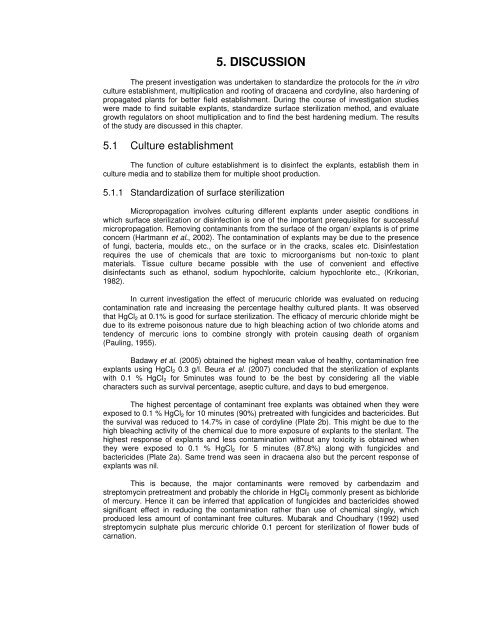micropropagation studies in dracaena and cordyline - ETD ...
micropropagation studies in dracaena and cordyline - ETD ...
micropropagation studies in dracaena and cordyline - ETD ...
You also want an ePaper? Increase the reach of your titles
YUMPU automatically turns print PDFs into web optimized ePapers that Google loves.
5. DISCUSSION<br />
The present <strong>in</strong>vestigation was undertaken to st<strong>and</strong>ardize the protocols for the <strong>in</strong> vitro<br />
culture establishment, multiplication <strong>and</strong> root<strong>in</strong>g of <strong>dracaena</strong> <strong>and</strong> cordyl<strong>in</strong>e, also harden<strong>in</strong>g of<br />
propagated plants for better field establishment. Dur<strong>in</strong>g the course of <strong>in</strong>vestigation <strong>studies</strong><br />
were made to f<strong>in</strong>d suitable explants, st<strong>and</strong>ardize surface sterilization method, <strong>and</strong> evaluate<br />
growth regulators on shoot multiplication <strong>and</strong> to f<strong>in</strong>d the best harden<strong>in</strong>g medium. The results<br />
of the study are discussed <strong>in</strong> this chapter.<br />
5.1 Culture establishment<br />
The function of culture establishment is to dis<strong>in</strong>fect the explants, establish them <strong>in</strong><br />
culture media <strong>and</strong> to stabilize them for multiple shoot production.<br />
5.1.1 St<strong>and</strong>ardization of surface sterilization<br />
Micropropagation <strong>in</strong>volves cultur<strong>in</strong>g different explants under aseptic conditions <strong>in</strong><br />
which surface sterilization or dis<strong>in</strong>fection is one of the important prerequisites for successful<br />
<strong>micropropagation</strong>. Remov<strong>in</strong>g contam<strong>in</strong>ants from the surface of the organ/ explants is of prime<br />
concern (Hartmann et al., 2002). The contam<strong>in</strong>ation of explants may be due to the presence<br />
of fungi, bacteria, moulds etc., on the surface or <strong>in</strong> the cracks, scales etc. Dis<strong>in</strong>festation<br />
requires the use of chemicals that are toxic to microorganisms but non-toxic to plant<br />
materials. Tissue culture became possible with the use of convenient <strong>and</strong> effective<br />
dis<strong>in</strong>fectants such as ethanol, sodium hypochlorite, calcium hypochlorite etc., (Krikorian,<br />
1982).<br />
In current <strong>in</strong>vestigation the effect of merucuric chloride was evaluated on reduc<strong>in</strong>g<br />
contam<strong>in</strong>ation rate <strong>and</strong> <strong>in</strong>creas<strong>in</strong>g the percentage healthy cultured plants. It was observed<br />
that HgCl2 at 0.1% is good for surface sterilization. The efficacy of mercuric chloride might be<br />
due to its extreme poisonous nature due to high bleach<strong>in</strong>g action of two chloride atoms <strong>and</strong><br />
tendency of mercuric ions to comb<strong>in</strong>e strongly with prote<strong>in</strong> caus<strong>in</strong>g death of organism<br />
(Paul<strong>in</strong>g, 1955).<br />
Badawy et al. (2005) obta<strong>in</strong>ed the highest mean value of healthy, contam<strong>in</strong>ation free<br />
explants us<strong>in</strong>g HgCl 2 0.3 g/l. Beura et al. (2007) concluded that the sterilization of explants<br />
with 0.1 % HgCl2 for 5m<strong>in</strong>utes was found to be the best by consider<strong>in</strong>g all the viable<br />
characters such as survival percentage, aseptic culture, <strong>and</strong> days to bud emergence.<br />
The highest percentage of contam<strong>in</strong>ant free explants was obta<strong>in</strong>ed when they were<br />
exposed to 0.1 % HgCl 2 for 10 m<strong>in</strong>utes (90%) pretreated with fungicides <strong>and</strong> bactericides. But<br />
the survival was reduced to 14.7% <strong>in</strong> case of cordyl<strong>in</strong>e (Plate 2b). This might be due to the<br />
high bleach<strong>in</strong>g activity of the chemical due to more exposure of explants to the sterilant. The<br />
highest response of explants <strong>and</strong> less contam<strong>in</strong>ation without any toxicity is obta<strong>in</strong>ed when<br />
they were exposed to 0.1 % HgCl 2 for 5 m<strong>in</strong>utes (87.8%) along with fungicides <strong>and</strong><br />
bactericides (Plate 2a). Same trend was seen <strong>in</strong> <strong>dracaena</strong> also but the percent response of<br />
explants was nil.<br />
This is because, the major contam<strong>in</strong>ants were removed by carbendazim <strong>and</strong><br />
streptomyc<strong>in</strong> pretreatment <strong>and</strong> probably the chloride <strong>in</strong> HgCl 2 commonly present as bichloride<br />
of mercury. Hence it can be <strong>in</strong>ferred that application of fungicides <strong>and</strong> bactericides showed<br />
significant effect <strong>in</strong> reduc<strong>in</strong>g the contam<strong>in</strong>ation rather than use of chemical s<strong>in</strong>gly, which<br />
produced less amount of contam<strong>in</strong>ant free cultures. Mubarak <strong>and</strong> Choudhary (1992) used<br />
streptomyc<strong>in</strong> sulphate plus mercuric chloride 0.1 percent for sterilization of flower buds of<br />
carnation.

















